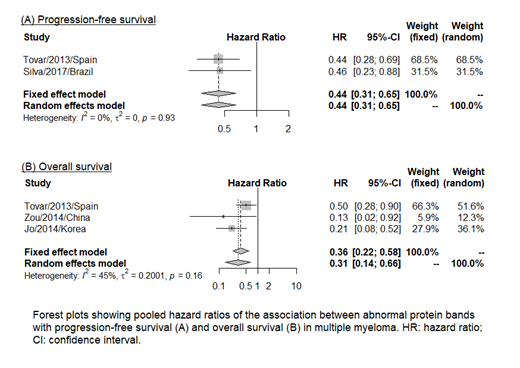Abstract
Introduction: The detection of abnormal protein bands (APB) different from the original monoclonal protein in patients with multiple myeloma (MM) who underwent stem cell transplantation and/or chemotherapy has been reported. These atypical serum immunofixation patterns may be monoclonal (also termed secondary monoclonal gammopathy of undetermined significance) or oligoclonal bands (OB). The prognostic significance of this phenomenon remains controversial. This systematic review and meta-analysis aimed to summarize and analyze the evidence for the association between APB with survival in MM patients.
Methods: A systematic search of PubMed, Cochrane, Google Scholar, Medline-Ovid, CINAHL, and ERIC, was conducted using relevant search terms. All studies were screened using predefined selection criteria and critically appraised for quality assessment following the Preferred Reporting Items for Systematic Reviews and Meta-analyses (PRISMA) guideline. All studies that described the presence of APB, defined as monoclonal spike with heavy or light chain immunoglobulin distinct from the original paraprotein at initial diagnosis of MM, and its associations with survival were included. Studies that reported multivariate adjusted hazard ratios (HR) were further included for meta-analysis. Random-effects model was used to synthesize the pooled HR estimate for the association of APB with survival. Cochran's Q statistics and I2 tests were used to evaluate statistical heterogeneity.
Results: A total of 24 out of 181 eligible studies were included for qualitative synthesis. Four studies (including 1115 patients) that reported HR estimates were included in the final meta-analysis. The random-effect summary HR for the progression-free survival among patients with APB was 0.44 (95% CI, 0.31-0.65) with no statistical heterogeneity (I2=0%, p=0.93). The pooled HR for the association with overall survival was 0.31 (95% CI, 0.14-0.66) with moderate statistical heterogeneity (I2=45%; p=0.16) for patients with APB. One study (Silva et al, 2017) only included patients with at least very good partial response while the other three studies reported similar findings of higher occurrence of APB with complete response (Tovar et al, 2013; Jo et al, 2014; Zou et al, 2014). These results are also consistent with the presumed association of APB with complete response as suggested in other studies included in qualitative review.
Conclusions: This study indicated a potential prognostic value of APB for favorable outcomes in the context of both overall and progression-free survival in MM patients after treatment. Further research is needed to evaluate the prognostic impact of the sole emergence of APB irrespective of treatment response.
Jamshed: Takeda: Honoraria.


